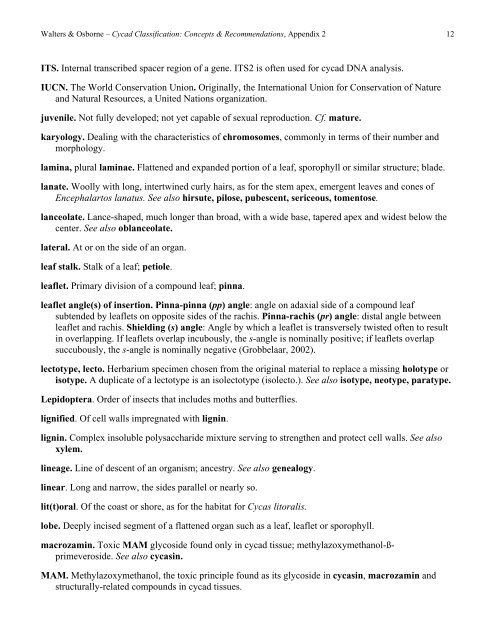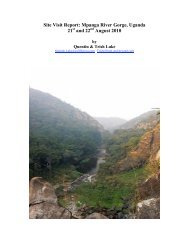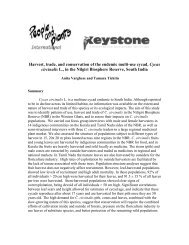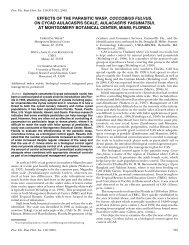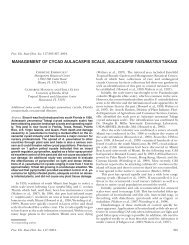Glossary of terms used in cycad systematics - Cycad Specialist Group
Glossary of terms used in cycad systematics - Cycad Specialist Group
Glossary of terms used in cycad systematics - Cycad Specialist Group
You also want an ePaper? Increase the reach of your titles
YUMPU automatically turns print PDFs into web optimized ePapers that Google loves.
Walters & Osborne – <strong>Cycad</strong> Classification: Concepts & Recommendations, Appendix 2 12<br />
ITS. Internal transcribed spacer region <strong>of</strong> a gene. ITS2 is <strong>of</strong>ten <strong>used</strong> for <strong>cycad</strong> DNA analysis.<br />
IUCN. The World Conservation Union. Orig<strong>in</strong>ally, the International Union for Conservation <strong>of</strong> Nature<br />
and Natural Resources, a United Nations organization.<br />
juvenile. Not fully developed; not yet capable <strong>of</strong> sexual reproduction. Cf. mature.<br />
karyology. Deal<strong>in</strong>g with the characteristics <strong>of</strong> chromosomes, commonly <strong>in</strong> <strong>terms</strong> <strong>of</strong> their number and<br />
morphology.<br />
lam<strong>in</strong>a, plural lam<strong>in</strong>ae. Flattened and expanded portion <strong>of</strong> a leaf, sporophyll or similar structure; blade.<br />
lanate. Woolly with long, <strong>in</strong>tertw<strong>in</strong>ed curly hairs, as for the stem apex, emergent leaves and cones <strong>of</strong><br />
Encephalartos lanatus. See also hirsute, pilose, pubescent, sericeous, tomentose.<br />
lanceolate. Lance-shaped, much longer than broad, with a wide base, tapered apex and widest below the<br />
center. See also oblanceolate.<br />
lateral. At or on the side <strong>of</strong> an organ.<br />
leaf stalk. Stalk <strong>of</strong> a leaf; petiole.<br />
leaflet. Primary division <strong>of</strong> a compound leaf; p<strong>in</strong>na.<br />
leaflet angle(s) <strong>of</strong> <strong>in</strong>sertion. P<strong>in</strong>na-p<strong>in</strong>na (pp) angle: angle on adaxial side <strong>of</strong> a compound leaf<br />
subtended by leaflets on opposite sides <strong>of</strong> the rachis. P<strong>in</strong>na-rachis (pr) angle: distal angle between<br />
leaflet and rachis. Shield<strong>in</strong>g (s) angle: Angle by which a leaflet is transversely twisted <strong>of</strong>ten to result<br />
<strong>in</strong> overlapp<strong>in</strong>g. If leaflets overlap <strong>in</strong>cubously, the s-angle is nom<strong>in</strong>ally positive; if leaflets overlap<br />
succubously, the s-angle is nom<strong>in</strong>ally negative (Grobbelaar, 2002).<br />
lectotype, lecto. Herbarium specimen chosen from the orig<strong>in</strong>al material to replace a miss<strong>in</strong>g holotype or<br />
isotype. A duplicate <strong>of</strong> a lectotype is an isolectotype (isolecto.). See also isotype, neotype, paratype.<br />
Lepidoptera. Order <strong>of</strong> <strong>in</strong>sects that <strong>in</strong>cludes moths and butterflies.<br />
lignified. Of cell walls impregnated with lign<strong>in</strong>.<br />
lign<strong>in</strong>. Complex <strong>in</strong>soluble polysaccharide mixture serv<strong>in</strong>g to strengthen and protect cell walls. See also<br />
xylem.<br />
l<strong>in</strong>eage. L<strong>in</strong>e <strong>of</strong> descent <strong>of</strong> an organism; ancestry. See also genealogy.<br />
l<strong>in</strong>ear. Long and narrow, the sides parallel or nearly so.<br />
lit(t)oral. Of the coast or shore, as for the habitat for Cycas litoralis.<br />
lobe. Deeply <strong>in</strong>cised segment <strong>of</strong> a flattened organ such as a leaf, leaflet or sporophyll.<br />
macrozam<strong>in</strong>. Toxic MAM glycoside found only <strong>in</strong> <strong>cycad</strong> tissue; methylazoxymethanol-ßprimeveroside.<br />
See also cycas<strong>in</strong>.<br />
MAM. Methylazoxymethanol, the toxic pr<strong>in</strong>ciple found as its glycoside <strong>in</strong> cycas<strong>in</strong>, macrozam<strong>in</strong> and<br />
structurally-related compounds <strong>in</strong> <strong>cycad</strong> tissues.


